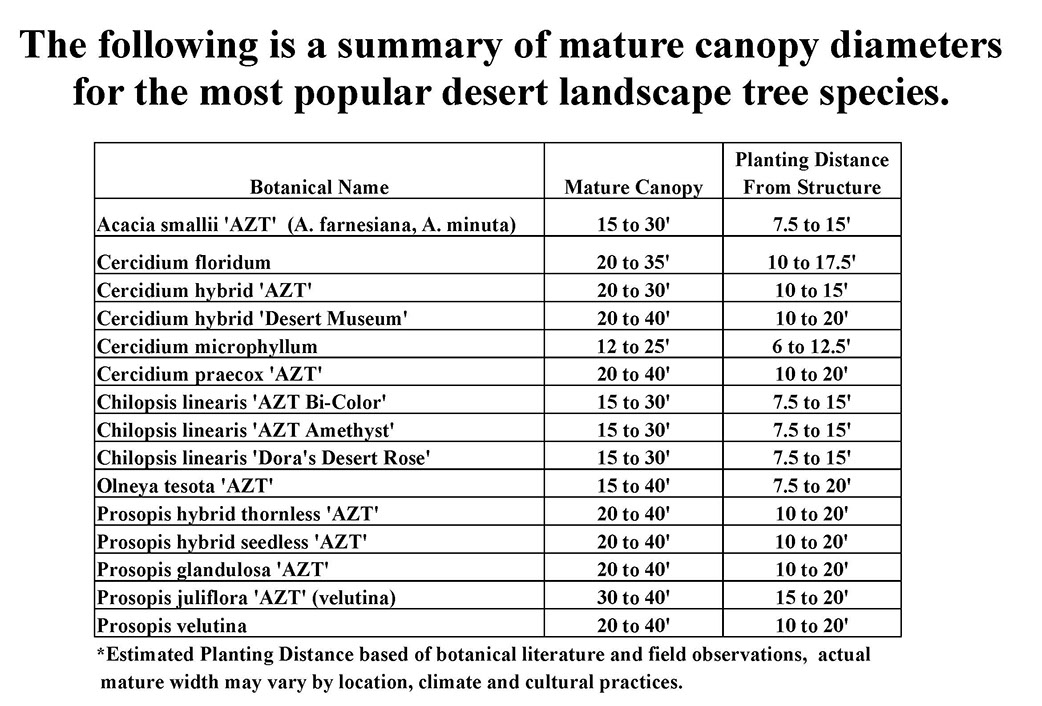


Tree Placement for Max Cooling and Energy Savings
Trees have become the centerpiece in the movement to make our lives, homes, communities and nation more environmentally friendly, or “Green.” An ever increasing body of academic and observational research supports the critical role played by trees in making our communities aesthetically pleasing, resource conserving and environmentally responsible. The ability of landscape trees to reduce the heat island effect, absorb CO2, reduce particulate pollutants from the air and rain water runoff, lower home and commercial utility bills, especially during hot summer months are increasingly well documented. The use of desert adapted landscape trees adds a water conversation dimension to this effort.
Studies at Pennsylvania State University Cooperative Extension showed homes located amid stands of tall trees reduced summer cooling costs approximately 75 percent when compared to homes in open sun. Shade trees reduce temperature primarily by blocking the sun's rays, reducing the amount of radiant energy transmitted to the surfaces they shade. Shade trees reduce solar heat gain by transferring the active heat-absorbing surface from an inert building envelope to living foliage. Large, deciduous, semi-deciduous, and evergreen trees have more surface area for transpiration, the evaporation of ground water as vapor through the leaves. If ample soil moisture is present and environmental conditions are suitable, water in the leaves evaporates in a process known as evapo-transpiration and the air is cooled. This means trees provide evaporative cooling, as well as shade. Deciduous and semi-deciduous trees have the added advantage of shedding some or all of their leaves in the winter, allowing the structures they shade to absorb and be heated naturally by the sun's rays. Vegetation can produce air temperature reductions as great as 10 degrees F compared to nearby areas with little vegetation. At this neighborhood scale, large populations of trees increase the aerodynamic roughness of the urban canopy layer, thereby reducing wind speeds by as much as 50%. A desired quality with our desert monsoon winds.
Not all trees and all locations are created equally when planting to reduce heat gain. Trees shading a west exposure from afternoon sun have the greatest impact on cooling savings. In Sacramento (climate zone 12), annual savings due to a single, 24 foot tall, 15 year old tree to the west of the building was 12 percent. Cooling savings from an east or southwest tree were approximately 50 percent less, and from a southeast, south or northwest tree 25 percent less than from a tree positioned on the west (a northeast tree had negligible impact). Savings decreases proportionally to tree age (i.e., tree size), since younger trees shaded less wall area than older trees with larger crowns. Multiple trees, obviously, amplify the amount of the shading and corresponding savings.
Distance from the structure is also critical. The amount and “quality/density” of shade tends to diminish as the building-to-tree distance increases. Trees should be planted so that the edge of the mature canopy is very close to the building. In some locations, emergency access to the structure and fire safely should also be considered. It is always tempting to position young trees near the structure for appearance purposes and to make the project look more landscaped. This can create long term problems with branches damaging roofs, windows and building surfaces.
Clearly, in the desert southwest, shade is king at least 8 to 9 months a year. Most desert adapted species are, in typical years, deciduous to semi-deciduous. This partial reduction in canopy will help improve warming of the structures during winter months.
In residential setting, incorporating properly positioned trees for optimal shade and energy conservation is relatively straightforward, especially in new landscape construction and landscape remodeling. Commercial projects present a different set of challenges. In the southwest most public roadways are oriented north-south and east-west, street visibility, product presentation and signage tend to trump energy conservation. Even with consideration for the particular needs of commercial buildings, it’s clear that with imagination and a commitment to proper landscape design and planting, even these structures can realize energy savings from strategic tree plantings.
Greg McPherson’s group at the USDA, Center for Urban Forest Research at the University of California, Davis developed the following recommendations when planting trees for energy conservation.
1. Individual trees should be located to provide maximum shade to west or southwest exterior window(s). Alternate choices are east and northwest, and where solar panel access isn't a consideration, southeast and south.
2. The largest windows without existing shading devices, with the preferred orientations listed above, should be the first choice for shading. For windows with shading devices, those with darker colors benefit most from shading.
3. Additional trees should be located to shade remaining windows on the west and southwest sides first, followed by the east side, and then the alternate locations listed above.
4. Shade tends to diminish as building-to-tree distance increases. Trees should be planted so that at maturity the edge of the canopy is very close to the building wall, consistent with other restraints, such as access and fire safety considerations.


© Copyright 2000-2020 Arid Zone Trees